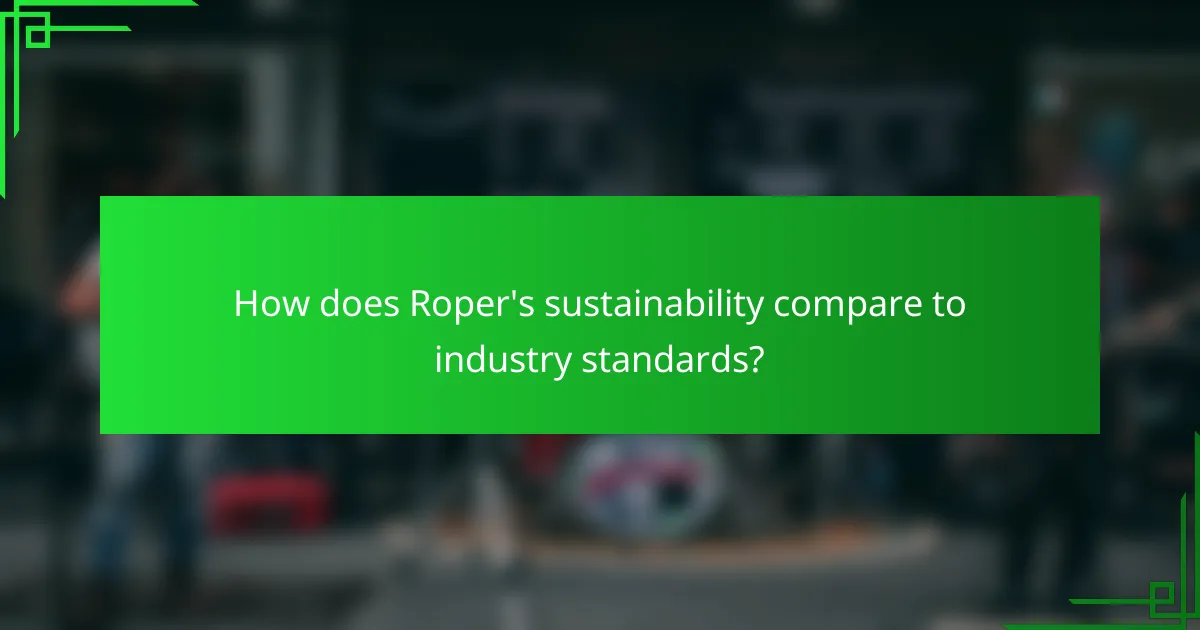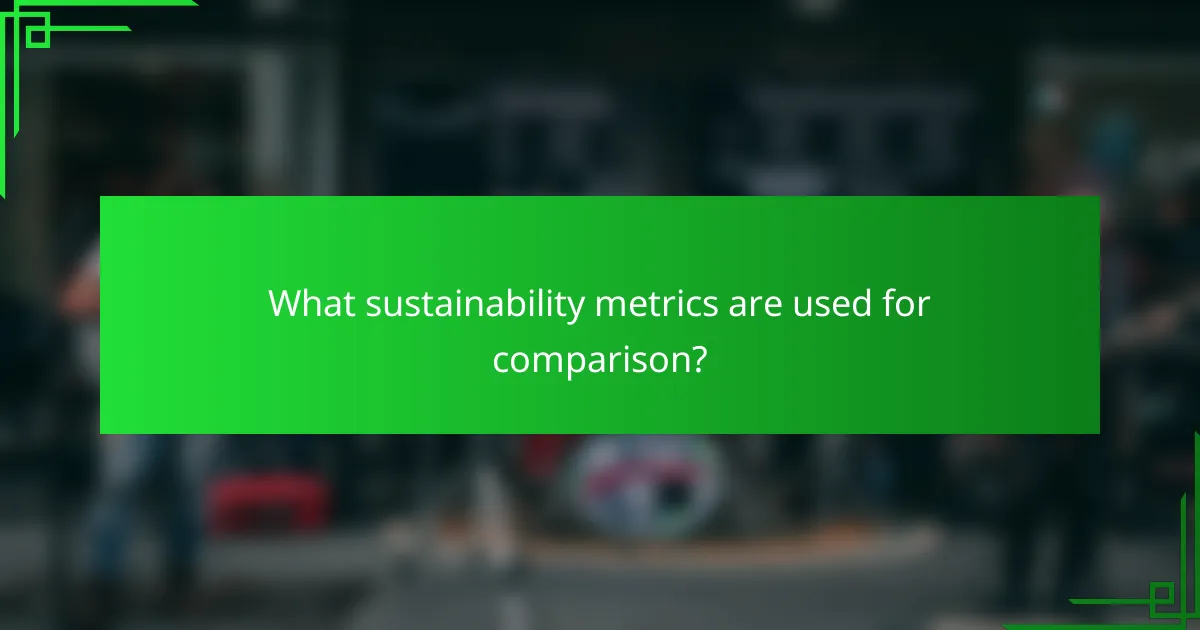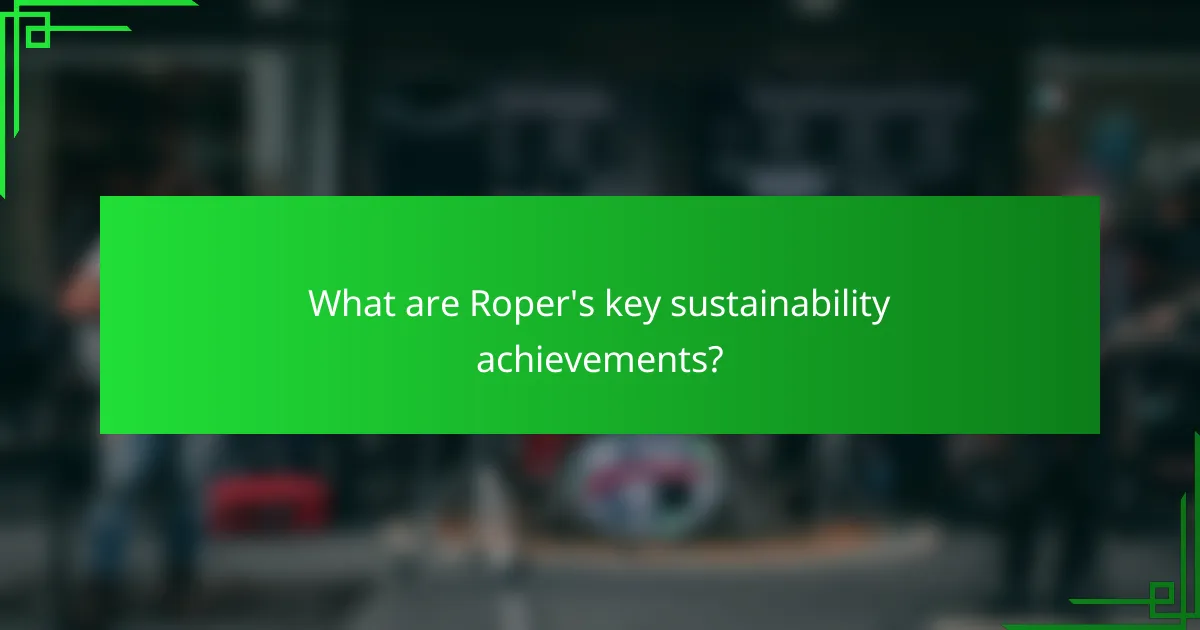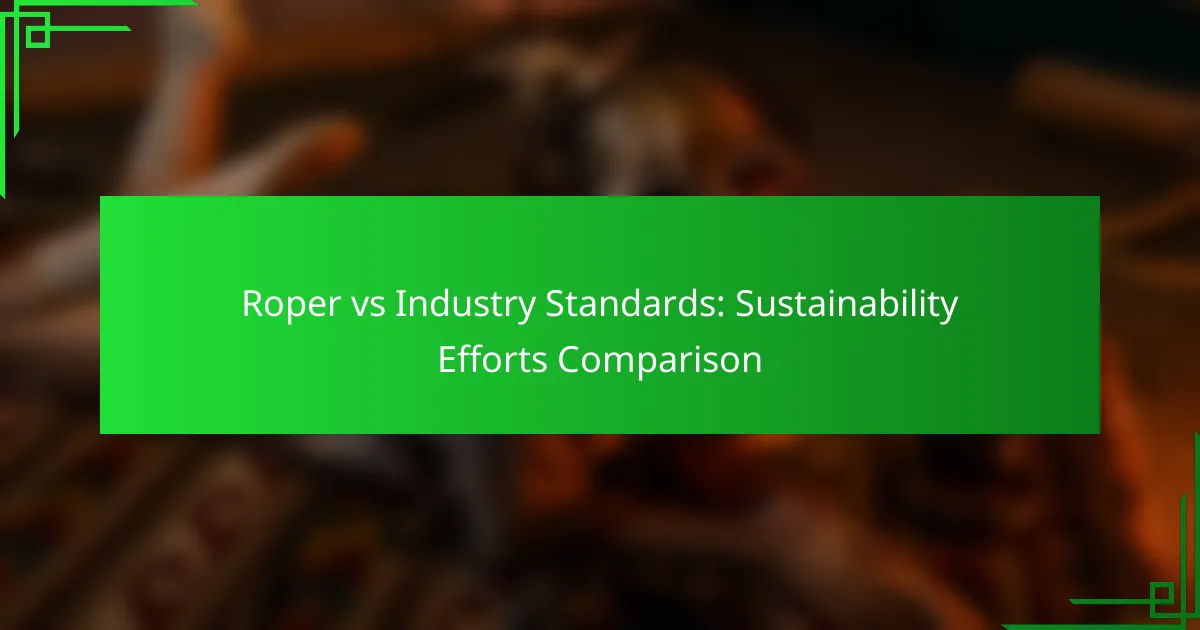Roper’s sustainability efforts reflect a commitment to reducing environmental impact and enhancing social responsibility, aligning closely with industry standards. While the company has made notable progress through initiatives like renewable energy adoption and community engagement, there are still areas where it can improve in comparison to its peers. Key metrics such as carbon footprint reduction and waste management practices serve as benchmarks for evaluating Roper’s performance in sustainability.

How does Roper’s sustainability compare to industry standards?
Roper’s sustainability efforts are generally aligned with industry standards, focusing on reducing environmental impact and enhancing social responsibility. However, specific initiatives and outcomes can vary, highlighting both strengths and areas for improvement compared to peers.
Roper’s sustainability initiatives
Roper has implemented various sustainability initiatives aimed at minimizing waste and energy consumption. These include optimizing manufacturing processes, investing in renewable energy sources, and enhancing product lifecycle management. Additionally, Roper emphasizes corporate social responsibility through community engagement and ethical sourcing practices.
For instance, Roper has set ambitious goals to reduce greenhouse gas emissions by a significant percentage over the next few years. They also prioritize sustainable materials in their products, which helps in reducing the overall environmental footprint.
Industry sustainability benchmarks
Industry sustainability benchmarks often focus on measurable outcomes such as carbon neutrality, waste reduction, and resource efficiency. Many companies aim for certifications like ISO 14001, which indicates a commitment to effective environmental management systems. Additionally, industry leaders typically publish annual sustainability reports to transparently share their progress and challenges.
Common benchmarks include achieving a certain percentage of renewable energy usage or reducing water consumption by specific amounts. These standards help companies gauge their performance against peers and drive continuous improvement.
Key differences in approaches
One key difference between Roper and industry standards is the pace of implementation. While Roper has made notable strides, some competitors have adopted more aggressive targets and timelines for sustainability goals. This can create a perception of Roper lagging in certain areas.
Another difference lies in the focus areas; Roper may prioritize certain initiatives over others, such as social responsibility, while other companies might emphasize environmental impact more heavily. This variation can lead to differing outcomes in sustainability performance metrics.

What sustainability metrics are used for comparison?
Sustainability metrics for comparison typically include carbon footprint reduction, water usage efficiency, and waste management practices. These metrics help assess the environmental impact of companies and their adherence to industry standards.
Carbon footprint reduction
Carbon footprint reduction measures the total greenhouse gas emissions produced directly and indirectly by a company. Effective strategies often involve transitioning to renewable energy sources, improving energy efficiency, and optimizing transportation logistics.
For instance, companies may aim to reduce their carbon emissions by 20-30% over a five-year period. Implementing energy-efficient technologies and encouraging telecommuting can significantly contribute to these reductions.
Water usage efficiency
Water usage efficiency evaluates how effectively a company utilizes water resources in its operations. This metric is crucial, especially in regions facing water scarcity, as it reflects a company’s commitment to sustainable practices.
Companies can improve water efficiency by adopting technologies such as rainwater harvesting systems and water recycling processes. Aiming for a reduction of 15-25% in water usage over several years is a common target.
Waste management practices
Waste management practices focus on how companies handle waste generated during production and operations. Effective waste management includes reducing, reusing, and recycling materials to minimize landfill contributions.
Companies often set goals to divert at least 50-70% of their waste from landfills through recycling and composting initiatives. Implementing a waste audit can help identify areas for improvement and track progress over time.

What are Roper’s key sustainability achievements?
Roper has made significant strides in sustainability through various initiatives aimed at reducing environmental impact and promoting social responsibility. Their achievements encompass renewable energy adoption, product lifecycle management, and community engagement programs.
Renewable energy adoption
Roper has committed to increasing its use of renewable energy sources across its operations. This includes investing in solar and wind energy projects, which help to lower greenhouse gas emissions and reduce reliance on fossil fuels.
For example, Roper has implemented solar panels at several facilities, generating a substantial portion of their energy needs. This shift not only supports sustainability goals but also leads to long-term cost savings on energy expenses.
Product lifecycle management
Roper emphasizes product lifecycle management by designing products that are more sustainable from inception to disposal. This involves using eco-friendly materials and ensuring products are recyclable or biodegradable at the end of their life.
Additionally, Roper conducts regular assessments to identify areas for improvement in product design and manufacturing processes, aiming to minimize waste and enhance resource efficiency. This approach aligns with global sustainability standards and consumer expectations for responsible products.
Community engagement programs
Roper actively engages with local communities to promote sustainability and social responsibility. Their programs often focus on education, environmental stewardship, and supporting local initiatives that align with their sustainability goals.
For instance, Roper partners with schools and non-profit organizations to provide resources and training on sustainable practices. These efforts not only foster community development but also enhance Roper’s reputation as a socially responsible company.

How do Roper’s sustainability efforts impact e-commerce?
Roper’s sustainability efforts significantly influence e-commerce by enhancing operational efficiency and appealing to environmentally conscious consumers. These initiatives can lead to cost savings and improved brand perception, ultimately driving sales and customer engagement.
Consumer purchasing decisions
Consumers are increasingly prioritizing sustainability when making purchasing decisions. A significant portion of shoppers, particularly millennials and Gen Z, prefer brands that demonstrate environmental responsibility. Roper’s commitment to sustainable practices can therefore attract these demographics, potentially increasing market share.
To capitalize on this trend, Roper should clearly communicate its sustainability initiatives on e-commerce platforms. Highlighting eco-friendly products and transparent sourcing can effectively influence consumer choices.
Supply chain transparency
Supply chain transparency is crucial for building trust with consumers. Roper’s sustainability efforts often involve disclosing sourcing practices and production methods, which can reassure customers about the ethical implications of their purchases. This transparency can differentiate Roper in a crowded e-commerce market.
Implementing tracking systems and sharing sustainability reports can enhance visibility. Roper could use digital tools to provide real-time updates on product origins, fostering a sense of accountability and encouraging responsible consumer behavior.
Brand loyalty and reputation
Roper’s sustainability efforts can significantly enhance brand loyalty and reputation. When consumers perceive a brand as committed to sustainability, they are more likely to remain loyal and recommend it to others. This loyalty can translate into repeat purchases and positive word-of-mouth marketing.
To strengthen brand reputation, Roper should engage in community initiatives and partnerships that promote sustainability. Collaborating with environmental organizations can further solidify its commitment and resonate with consumers who value corporate social responsibility.

What are the challenges Roper faces in sustainability?
Roper faces several challenges in sustainability, primarily related to regulatory compliance and the cost of sustainable materials. These issues can hinder their ability to implement effective sustainability practices while maintaining profitability.
Regulatory compliance issues
Roper must navigate a complex landscape of environmental regulations that vary by region. Compliance with these regulations often requires significant investment in new technologies and processes, which can be a barrier to implementing sustainable practices.
For example, regulations such as the European Union’s REACH (Registration, Evaluation, Authorisation and Restriction of Chemicals) impose strict requirements on the use of certain chemicals. Failing to comply can result in hefty fines and damage to the company’s reputation.
Cost of sustainable materials
The transition to sustainable materials often comes with higher upfront costs, which can affect Roper’s pricing strategy. Sustainable alternatives may not only be more expensive but also less readily available, complicating supply chain management.
For instance, while recycled plastics can reduce environmental impact, they typically cost more than virgin materials. Roper must weigh the long-term benefits of sustainability against these immediate financial implications to make informed decisions.
